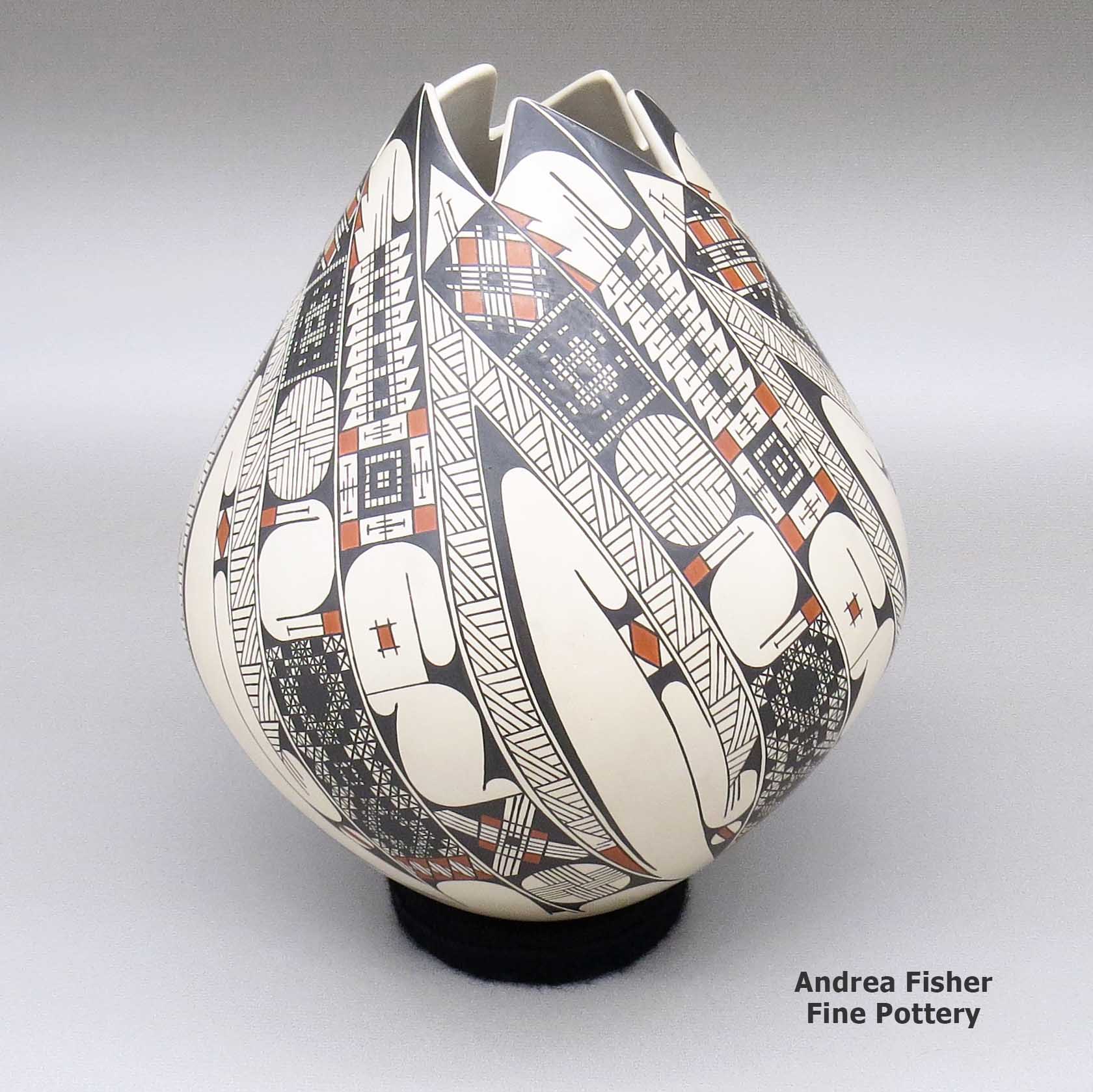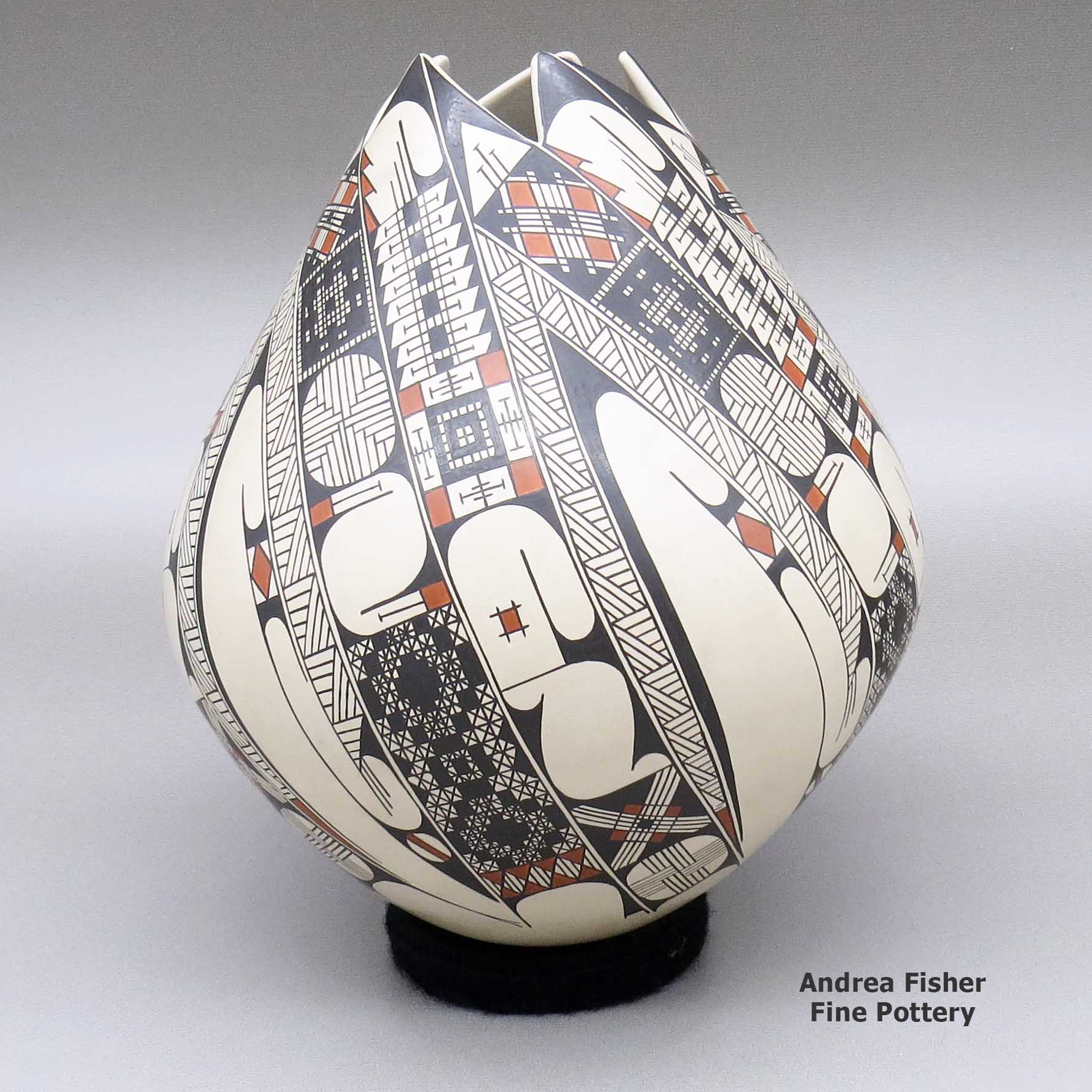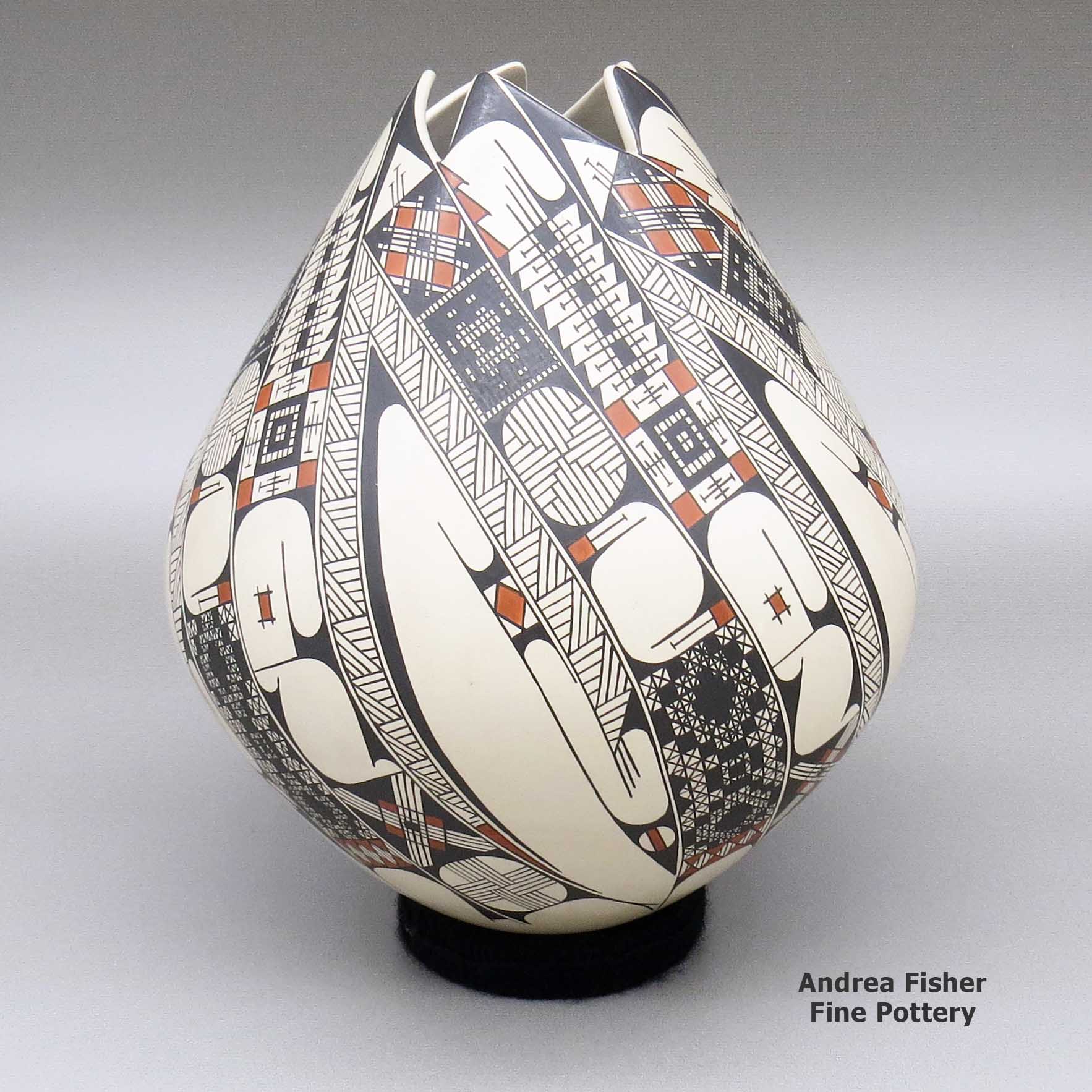| Dimensions | 6.25 × 6.25 × 8.5 in |
|---|---|
| Measurement | Measurement includes stand |
| Condition of Piece | Very good, normal wear |
| Signature | Jose L Loya |
Jose Luis Loya, lscg3b171, Polychrome jar with a geometric opening and design
$725.00
A polychrome jar with a geometric cut opening and painted with a geometric design
In stock
Brand
Loya, Jose Luis
About Mata Ortiz and Casas Grandes
Mata Ortiz is a small settlement inside the bounds of the Casas Grandes municipality, very near the site of Paquimé. The fortunes of the town have gone up and down over the years with a real economic slump happening after the local railroad repair yard was relocated to Nuevo Casas Grandes in the early 1960s. It was a village with a past and little future.
A problem around the ancient sites has been the looting of ancient pottery. From the 1950s on, someone could dig up an old pot, clean it up a bit and sell it to an American dealer (and those were everywhere) for more money than they'd make in a month with a regular job. And there's always been a shortage of regular jobs.
Many of the earliest potters in Mata Ortiz began learning to make pots when it started getting harder to find true ancient pots. So their first experiments turned out crude pottery but with a little work, their pots could be "antiqued" enough to pass muster as being ancient. Over a few years each modern potter got better and better until finally, their work could hardly be distinguished from the truly ancient. Then the Mexican Antiquities Act was passed and terror struck: because the old and the new could not be differentiated, potters were having all their property seized and their families put out of their homes because of "antiqued" pottery they made just yesterday. Things had to change almost overnight and several potters destroyed large amounts of their own inventory because it looked "antique." Then they went about rebooting the process and the product in Mata Ortiz.
For more info:
Mata Ortiz pottery at Wikipedia
Mata Ortiz at Wikipedia
Casas Grandes at Wikipedia
Contemporary Pottery
The term "contemporary" has several possible shadings in reference to Southwestern pottery. At some pueblos, it's more an indicator of a modern style of carving or etching than anything else. At San Felipe it refers to almost anything newly made there as they have almost no prehistoric templates to work from. At Jemez the situation resolved to where what makes a piece uniquely "Jemez" is the clay. Any designs on that clay can be said to be "contemporary."
About Jars
The jar is a basic utilitarian shape, a container generally for cooking food, storing grain or for carrying and storing water. The jar's outer surface is a canvas where potters have been expressing their religious visions and stories for centuries.
In Sinagua pueblos (in northern Arizona), the people made very large jars and buried them up to their openings in the floors of the hidden-most rooms in their pueblo. They kept those jars filled with water but also kept smaller jars of meat and other perishables inside those jars in the water. It's a form of refrigeration still in use among indigenous people around the world.
Where bowls tend to be low, wide and with large openings, jars tend to be more globular: taller, less wide and with smaller openings.
For a potter looking at decorating her piece, bowls are often decorated inside and out while most jars are decorated only on the outside. Jars have a natural continuity to their design surface where bowls have a natural break at the rim, effectively yielding two design surfaces on which separate or complimentary stories can be told.
Before the mid-1800s, storage jars tended to be quite large. Cooking jars and water jars varied in size depending on how many people they were designed to serve. Then came American traders with enameled metal cookware, ceramic dishes and metal eating utensils...Some pueblos embraced those traders immediately while others took several generations to let them and their innovations in. Either way, opening those doors led to the virtual collapse of utilitarian pottery-making in most pueblos by the early 1900s.
In the 1920s there was a marked shift away from the machinations of individual traders and more toward marketing Native American pottery as an artform. Maria Martinez was becoming known through her exhibitions at various major industrial fairs around the country and Nampeyo of Hano was demonstrating her art for the Fred Harvey Company at the Grand Canyon. The first few years of the Santa Fe Indian Market helped to solidify that movement and propel it forward. It took another couple generations of artists to open other venues for their art across the country and turn Native American art into the phenomenon it has become.
Today's jars are artwork, not at all for utilitarian purposes, and their shapes, sizes and decorations have evolved to reflect that shift.
About Geometric Designs
"Geometric design" is a catch-all term. Yes, we use it to denote some kind of geometric design but that can include everything from symbols, icons and designs from ancient rock art to lace and calico patterns imported by early European pioneers to geometric patterns from digital computer art. In some pueblos, the symbols and patterns denoting mountains, forest, wildlife, birds and other elements sometimes look more like computer art that has little-to-no resemblance to what we have been told they symbolize. Some are built-up layers of patterns, too, each with its own meaning.
"Checkerboard" is a geometric design but a simple black-and-white checkerboard can be interpreted as clouds or stars in the sky, a stormy night, falling rain or snow, corn in the field, kernels of corn on the cob and a host of other things. It all depends on the context it is used in, and it can have several meanings in that context at the same time. Depending on how the colored squares are filled in, various basket weave patterns can easily be made, too.
"Cuadrillos" is a term from Mata Ortiz. It denotes a checkerboard-like design using tiny squares filled in with paints to construct larger patterns.
"Kiva step" is a stepped geometric design pattern denoting a path into the spiritual dimension of the kiva. "Spiral mesa" is a similar pattern, although easily interpreted with other meanings, too. The Dineh have a similar "cloud terrace" pattern.
That said, "geometric designs" proliferated on Puebloan pottery after the Spanish, Mexican and American settlers arrived with their European-made (or influenced) fabrics and ceramics. The newcomers' dinner dishes and printed fabrics contributed much material to the pueblo potters design palette, so much and for so long that many of those imported designs and patterns are considered "traditional" now.





